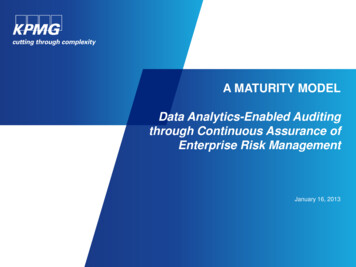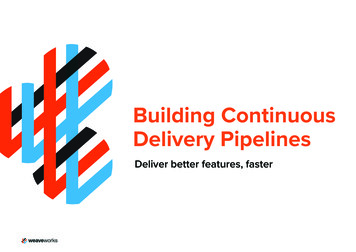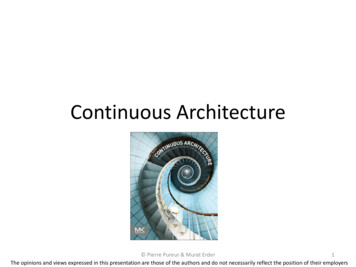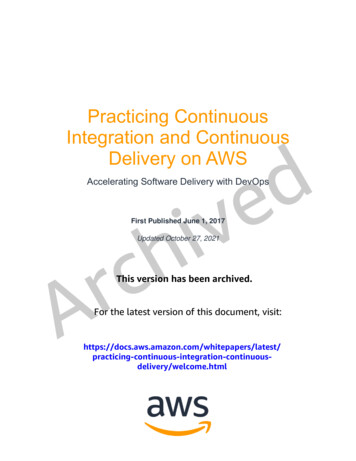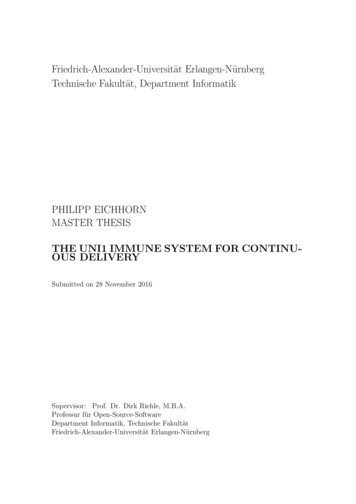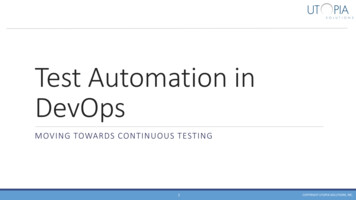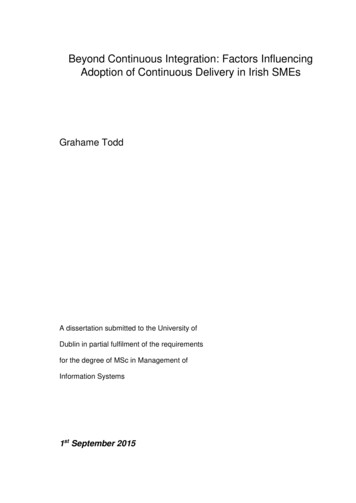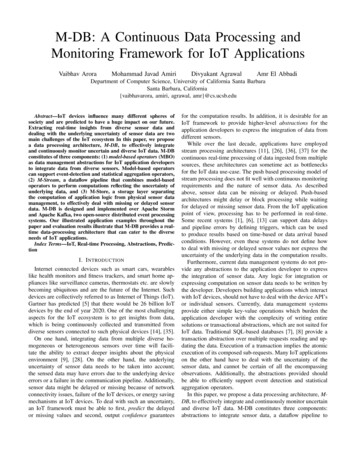
Transcription
M-DB: A Continuous Data Processing andMonitoring Framework for IoT ApplicationsVaibhav AroraMohammad Javad AmiriDivyakant AgrawalAmr El AbbadiDepartment of Computer Science, University of California Santa BarbaraSanta Barbara, California{vaibhavarora, amiri, agrawal, amr}@cs.ucsb.eduAbstract—IoT devices influence many different spheres ofsociety and are predicted to have a huge impact on our future.Extracting real-time insights from diverse sensor data anddealing with the underlying uncertainty of sensor data are twomain challenges of the IoT ecosystem In this paper, we proposea data processing architecture, M-DB, to effectively integrateand continuously monitor uncertain and diverse IoT data. M-DBconstitutes of three components: (1) model-based operators (MBO)as data management abstractions for IoT application developersto integrate data from diverse sensors. Model-based operatorscan support event-detection and statistical aggregation operators,(2) M-Stream, a dataflow pipeline that combines model-basedoperators to perform computations reflecting the uncertainty ofunderlying data, and (3) M-Store, a storage layer separatingthe computation of application logic from physical sensor datamanagement, to effectively deal with missing or delayed sensordata. M-DB is designed and implemented over Apache Stormand Apache Kafka, two open-source distributed event processingsystems. Our illustrated application examples throughout thepaper and evaluation results illustrate that M-DB provides a realtime data-processing architecture that can cater to the diverseneeds of IoT applications.Index Terms—IoT, Real-time Processing, Abstractions, PredictionI. I NTRODUCTIONInternet connected devices such as smart cars, wearableslike health monitors and fitness trackers, and smart home appliances like surveillance cameras, thermostats etc. are slowlybecoming ubiquitous and are the future of the Internet. Suchdevices are collectively referred to as Internet of Things (IoT).Gartner has predicted [5] that there would be 26 billion IoTdevices by the end of year 2020. One of the most challengingaspects for the IoT ecosystem is to get insights from data,which is being continuously collected and transmitted fromdiverse sensors connected to such physical devices [14], [35].On one hand, integrating data from multiple diverse homogeneous or heterogeneous sensors over time will facilitate the ability to extract deeper insights about the physicalenvironment [9], [28]. On the other hand, the underlyinguncertainty of sensor data needs to be taken into account;the sensed data may have errors due to the underlying deviceerrors or a failure in the communication pipeline. Additionally,sensor data might be delayed or missing because of networkconnectivity issues, failure of the IoT devices, or energy savingmechanisms at IoT devices. To deal with such an uncertainty,an IoT framework must be able to first, predict the delayedor missing values and second, output confidence guaranteesfor the computation results. In addition, it is desirable for anIoT framework to provide higher-level abstractions for theapplication developers to express the integration of data fromdifferent sensors.While over the last decade, applications have employedstream processing architectures [11], [26], [36], [37] for thecontinuous real-time processing of data ingested from multiplesources, these architectures can sometime act as bottlenecksfor the IoT data use-case. The push based processing model ofstream processing does not fit well with continuous monitoringrequirements and the nature of sensor data. As describedabove, sensor data can be missing or delayed. Push-basedarchitectures might delay or block processing while waitingfor delayed or missing sensor data. From the IoT applicationpoint of view, processing has to be performed in real-time.Some recent systems [1], [6], [13] can support data delaysand pipeline errors by defining triggers, which can be usedto produce results based on time-based or data arrival basedconditions. However, even these systems do not define howto deal with missing or delayed sensor values nor express theuncertainty of the underlying data in the computation results.Furthermore, current data management systems do not provide any abstractions to the application developer to expressthe integration of sensor data. Any logic for integration orexpressing computation on sensor data needs to be written bythe developer. Developers building applications which interactwith IoT devices, should not have to deal with the device API’sor individual sensors. Currently, data management systemsprovide either simple key-value operations which burden theapplication developer with the complexity of writing entiresolutions or transactional abstractions, which are not suited forIoT data. Traditional SQL-based databases [7], [8] provide atransaction abstraction over multiple requests reading and updating the data. Execution of a transaction implies the atomicexecution of its composed sub-requests. Many IoT applicationson the other hand have to deal with the uncertainty of thesensor data, and cannot be certain of all the encompassingobservations. Additionally, the abstractions provided shouldbe able to efficiently support event detection and statisticalaggregation operators.In this paper, we propose a data processing architecture, MDB, to effectively integrate and continuously monitor uncertainand diverse IoT data. M-DB constitutes three components:abstractions to integrate sensor data, a dataflow pipeline to
perform computations reflecting the uncertainty of the underlying data, and a storage layer separating the computation ofbusiness logic from the physical sensor data management.First, Model-based Operators are proposed as abstractionsfor the IoT application developer, to express the integrationof diverse sensor data. Model-based Operators (MBO) canintegrate data in spatial, temporal or spatio-temporal domains,and support event-detection and statistical aggregation operators. MBOs are defined by specifying a model of executionusing threshold-based, aggregate or user-defined functions tointegrate data, and output a degree of confidence in theexecution to express the underlying uncertainty of sensor data.Second, we propose a computation framework named MStream, which represents the processing pipeline of the application by combining model-based operators in the form ofa dataflow graph and continuously executing the model-basedoperators at defined time intervals.Third, a datastore interface, M-Store, is employed to hide thecomplexity of sensor data aggregation from the real-time dataprocessing in M-Stream. M-Store provides access to sensorand non-sensor data, and gives M-DB the ability to employprediction models to incorporate missing or delayed values.The paper makes the following contributions: Model-based operators are proposed as abstractions toIoT applications to integrate data from diverse sensors,and enable temporal, spatial or spatio-temporal integration. MBOs provide support for event-detection orstatistical aggregation like operations, and their executionreflects the uncertainty in the underlying data. M-DB provides the ability to express the uncertaintyof computational results in a data-processing pipelinevia confidence values provided by MBOs. M-Streamcombines MBOs in a dataflow graph, which ensures thatthe underlying uncertainty in the data can flow along thecomputation pipeline. M-DB’s architecture generates real-time results, even inthe presence of missing or delayed sensor values, first, byseparating the execution in M-Stream from the physicalhandling of sensor data in M-Store, and second, byutilizing prediction models in M-Store to fill in missingor delayed sensor data.The rest of the paper is organized as follows. Section II givesan overview of M-DB. The details of model-based operatorsare presented in Section III. Section IV introduces M-DB’sarchitecture. The implementation of M-DB over Apache Stormand Apache Kafka is described in Section V. Experimentalresults are presented in Section VI and Section VII discussesthe related work. The paper concludes in Section VIII.II. M-DB OVERVIEWM-DB supports event-detection and statistical aggregationuse-cases, by building on model-based operators, and combining and executing them via dataflow pipelines. Figure 1illustrates M-DB’s architecture. M-DB builds on the Modelbased operators abstraction, and employs a computationalpipeline, M-Stream. A storage abstraction, M-Store, is usedfor accessing and managing sensor and non-sensor data.Fig. 1: M-DB ArchitectureM-DB employs the model-based operation abstraction tointegrate sensor, as well as non-sensor data. Offering a modelbased operator abstraction to the application developer atthe data management layer provides the advantage of hidingthe complexity of integrating data from multiple sensors.Furthermore, it allows for better modularity and code re-use asmultiple IoT applications can be built using the same modelbased operator abstractions. Model-based operators are of 4different types, to support temporal, spatial, and two varietiesof spatio-temporal integration respectively. Different modelbased operators can be defined, based on the needs of theparticular application. Following are three applications to showdifferent use-cases for model-based operators. Detecting abnormal vibration in a turbine where a predefined percentage of sensor values in a given periodexceed a pre-defined threshold [21] (Event-detection viaTemporal Integration of Homogeneous sensors).A fitness app that tracks aggregate statistics like distancerun, time elapsed etc. over a group of runners (StatisticalAggregation via Spatio-temporal Integration of Homogeneous sensors).Making decision to provide drug doses to patients basedon multiple medical sensors calculating, blood pressure,heart rate etc. (Event-detection via Spatial Integration ofHeterogeneous sensors).M-Stream provides the ability to combine the definedmodel-based operation executions in a processing pipeline inthe form of a dataflow graph, to represent the computationalneeds of IoT applications. In Figure 1, M BO1 illustrates amodel-based operator, which integrates data from two sensors,s1 and s2 and outputs the outcome with confidence c1 . Modelbased operator M BO2 integrates values from sensors s2 , s3 ,a non-sensor input value, x, and the output from M BO1 ’sexecution, c1 , and outputs c2 . Finally, M BO3 integrates valuesfrom sensor s4 , with the the output of M BO2 . If M BO3succeeds, which is determined by the definition of M BO3 (incase of a thresholding operation), then data item y will beupdated in the datastore.M-Stream’s design aids M-DB in dealing with missingor uncertain sensor data. To capture the uncertainty of theunderlying data, M-Stream utilizes the confidence in the computation of model-based operations. The confidence functionassociated with the model-based operator definition is used toreflect the certainty in the computation as a function of the
input data. The dataflow pipeline in M-Stream then ensuresthat the uncertainty in a MBO computation captured by itsconfidence can flow through the data processing pipeline, asan input to connected model-based operators. This way, theuncertainty can be reflected in downstream computations.M-Stream employs a continuous processing model to compute the model-based operations periodically after a definedtime period. A continuous processing and pull-based modelis combined with the traditional push-based stream processingmodel to perform computations.To separate sensor data management from the continuousreal-time dataflow computations defined on correspondingdata, M-DB employs M-Store. M-Store stores, processes andprovides API access to sensor and non-sensor data in MStream. The separation of concerns also gives M-Store theability to incorporate prediction models to fill in missing ordelayed sensor data values. M-Stream can then use the confidence values to reflect the uncertainty of MBO computationson predicted data.III. M ODEL - BASED O PERATOR A BSTRACTIONModel-based operators provide the ability to integrate datafrom homogeneous or heterogeneous sensors in both spatialand temporal domain. In this section, we introduce four different model-based operators to integrate data over the temporal,spatial, and spatio-temporal domains. We mainly focus ontwo classes of applications: event detection and statisticalaggregation. In event detection applications, a thresholdingfunction is defined to determine whether an event occurs ornot, and in statistical aggregation, an aggregation functionis defined to integrate data over the temporal or spatialdomain. Note that aggregation functions are mainly targetedfor homogeneous sensors, where all the sensor values are ofthe same type. In addition to event detection and statisticalaggregation application classes, we allow developers to definetheir own (user-defined) functions to integrate data.We first define two functions ρ and ψ to integrate data overthe temporal and spatial domains respectively and then definemodel-based operators.Function ρ is defined on the values received from a sensorover a time period. The definition of ρ depends on theapplication class. For event detection applications, ρ is afunction with an input consisting of four elements: a set ofsensor values, a threshold τ , an inequality operator σ (σ is , , , , , or 6 ), and a percentage p. ρ returns trueif at least p percent of the values received from the sensorsatisfy the threshold τ based on the operator σ. In statisticalaggregation use-cases, ρ is an aggregation function, e.g., sum,average, min, and max, with a set of sensor values as input andan aggregated value as output. In general-purpose applications,ρ is a user-defined function with a set of sensor values as inputand a user-specified output.Function ψ is defined in a similar way on values receivedfrom a set of sensors at one time-point (one value per sensor).Since values are from different sensors, for event detectionapplications, we need to define a threshold τ and an inequalityoperator σ for each sensor (value). Same as before, functionψ returns true, if at least p percent of the values receivedfrom the sensors satisfy their own threshold τ based on theirown operator σ. In statistical aggregation applications, ψ is anaggregation function. Finally, in general-purpose applications,ψ has sensor values as input and a user-specified output. Wenow proceed to define different model-based operators.A. Temporal Model-based OperatorWe first provide an abstraction to integrate the data froma single sensor in the temporal domain. The values areconsidered as real numbers which are received on a regularbasis. The time domain is modeled as an ordered, infinite setof discrete time points where each time point is basically asequence number. A temporal model-based operator T M BOintegrates received values at each time period. To specifytime periods we use time-based sliding windows [32]. Notethat sliding windows are generic enough to express windowswith arbitrary progression steps or even tumbling windows(fixed-sized, non-overlapping time intervals). When a timewindow is finished, the operator integrates received valuesin that time window using function ρ. In the case of eventdetection applications, the model-based operator is said to beexecuted if function ρ returns true (at least p percent of thevalues received from the sensor in the time window satisfythreshold τ ). The confidence c of execution is determined bya user-defined function ϕ. O is also a finite set of outputs ofthe model-based operator if the operator is considered to beexecuted successfully. The outputs may either be written to thedatastore or might be inputs to other model-based operators.Note that model-based operators can fuse non-sensor inputswith sensor inputs as well. A non-sensor input such as a dataitem with key k and value val can be represented as inputfrom sensor k with value val.Definition: A Temporal Model-based Operator is a tupleT M BO (s, V, w, T , γ, ρ, ϕ, c, O) where s is a single sensor, V R is a set of (sensor) values, w is the length of each time window, T is a set of time-points, γ : V T is a mapping that assigns time points to values, ρ is the temporal integration function that integrates dataover each time window, ϕ is a (user-defined) mapping that returns the executionconfidence c [0, 1] for each time window based on themappings γ and ρ, and O is a set of outputs.For example, in the case of the vibration detection use-casedescribed earlier, the application developer wants the detectionto be made based on values received from a single sensor overa time period. Consider a MBO with a time window of length6. where V {5, 7, 10, 9, .} is the set of received valuesand γ(5) 1, γ(7) 3, γ(10) 5, and γ(9) 7 are thetime-points within the two first time windows (data is receivedfrom the sensor every 2 time units). Since vibration detectionis an event detection application, ρ is defined as a thresholding
function. Let τ 8, p 0.6 and the inequality operator be“ ” (a sensor value satisfies the threshold if it is less than τ ).Here, in the first time window, since 0.66 of the time-points(time-points 1 and 3) have values less than 8, the thresholdcondition is satisfied, function ρ returns true and the modelbased operator executes successfully, but in the second timewindow, only time-point 3 (with value 7) satisfies the thresholdcondition, so function ρ returns false and the operator fails.The user-defined function ϕ can be specified as the ratio ofvalues that satisfy the threshold τ to the total number of values(time points) in a time window. Using this definition, ϕ returns0.66 as the execution confidence for the first time windowin the above example. The definition of ϕ given here is oneway of computing the confidence. Applications might use adifferent definition based on the context.B. Spatial Model-based OperatorThe next model based operator is defined to integrate dataover multiple sensors. Note that we use the term spatialreferring to different physical sensors being usually present atdifferent locations. Values from different sensors can representvalues from different related locations, like soil moisturereadings from different locations on a farm. Alternatively, theymight provide information about different physical attributesof a single location, e.g., integrating data from multiple sensorsthat send information about a patient’s blood pressure, heartrate, insulin level etc. to perform continuous health monitoringand administer medicines.The Spatial Model-based Operator is composed of n sensors, s1 , s2 , ., sn . Each sensor si has a value associatedwith it, vi , which is emitted periodically. The spatial modelbased operator, S M BO, receives values from all sensorsat each time point ti T and immediately integrates themusing function ψ (unlike the temporal model-based operatorwhere we wait till the end of a time window). To handle nonsynchronized sensor values, a time interval δ is also defined.Value v is considered to be received at time point t if v arrivesin [t δ, t δ]. In the case of event detection applications, aspatial model-based operator executes successfully if functionψ returns true (at least p percent of the n sensors values satisfytheir defined thresholds). Similar to the temporal operator, theconfidence c is determined by a user-defined function ϕ.Definition: A Spatial Model-based Operator is a tupleS M BO (S, V, T , δ, γ, ψ, ϕ, c, O) where S is a finite set of sensors,V R is a set of (sensors) values,T is a set of time-points,δ is a time interval that is used to synchronize values,γ : S T V is a partial mapping that assigns a valueto each sensor at each time point,ψ is the spatial integration function,ϕ is a (user-defined) mapping that returns the executionconfidence c [0, 1] based on mappings γ and ψ, andO is a set of outputs.Fig. 2: Two Applications of Spatio-temporal OperatorsC. Spatio-Temporal Model-based OperatorsThe last two model based operators are defined to integratedata over both spatial and temporal domains where the systemis composed of n sensors, s1 , s2 , ., sn and each sensor sisends a set of values vi1 , vi2 , ., vim over m time-points withina time window. We define two different operators ST M BOand T S M BO. In ST M BO, the operator first integratesdata over the spatial domain (using function ψ) and thenover the temporal domain (using function ρ). Whereas, inT S M BO, the operator first integrates data over the temporaldomain and then over the spatial domain. The confidence c isalso returned by a user-defined function ϕ using the valuesreturned by ψ and ρ.In ST M BO, a function ψ integrates data at each timepoint ti and returns some value vi . Theses values are thenintegrated over the temporal domain using a function ρ. Then,a user-defined function ϕ is used to determine confidence c.Similar to Spatial operator, a time interval δ is also defined tohandle non-synchronized sensor values (value v is consideredto be received at time-point t if v arrives in [t δ, t δ]).Definition: A Spatio-Temporal Model-based Operator is atuple ST M BO (S, V, w, T , γ, δ, ψ, ρ, ϕ, c, O) where S is a finite set of sensors,V R is a set of (sensor) values,w the length of each time window,T is a set of time-points,γ : S T V is a partial mapping that assigns a valueto each sensor at each time-point,δ is a time interval that is used to synchronize values,ψ is a (spatial) function that integrates values at each timepoint and returns a single value,ρ is a (temporal) function that integrates values resultedfrom ψ and returns the final value,ϕ is a (user-defined) function that returns the executionconfidence c [0, 1] using the values from functions ψand ρ, andO is a set of outputs.Here since we use both ρ and ψ functions, two classes ofapplications can be combined. However, the combination ofdifferent application classes might not be always meaningful,e.g., if ψ is a thresholding function (returns true/false), thenρ cannot be a thresholding or an aggregation function.
Figure 2(a) shows a rainfall measurement application wherea set of sensors are distributed in different regions. Forsimplicity, we consider a set of 3 sensors (S {s1 , s2 , s3 })and one time window consisting of time-points t1 , t2 , and t3 .Let ψ be a function that returns the average rainfall at eachtime-point (since the sensors are homogeneous, we can havesuch a function), so ψ(t1 ) 1.8(mm), ψ(t2 ) 2.0, andψ(t3 ) 1.6, and ρ be a sum function over the values resultedby ψ, so ρ returns 5.4 that means, on average, we had 5.4 mmrainfall per region.ST M BO is useful for applications where all sensors sendvalues in all the defined time-points. In such situation, the ψfunction can be computed for each time point as soon as itsvalues are received and does not need to wait till the end ofthe time window. However, if each sensor sends data in some(not all) of the defined time-points, integrating data at eachtime point might not be possible. To capture those situations,T S M BO is introduced. T S M BO is defined similar toST M BO, except it changes the order of execution of ψand ρ. First, ρ integrates data received from each sensor overthe temporal domain and then ψ plays its role to integrate theresulted values of ρ and return the final value.Figure 2(b) represents a running tracker application thatkeeps track of running distances per day and returns the mostactive runner among a group of users. This value could beused later for some health care analysis. T S M BO can beused in this scenario. For simplicity we consider a group of 3users (s1 , s2 , and s3 ) and sensors send data every 15 minutes.Here each user’s device has a sensor and the time windowduration is a day. The figure only shows the time points thatdata is received from any of the users. As can be seen user 1runs from 8 to 9 at morning (the values are sent at time-points8:15, 8:30, 8:45 and 9:00), user 2 runs from 11 to 11:30, anduser 3 runs from 8 to 8:30 at morning and then 11 to 11:30.Let ρ be a sum function, so ρ(s1 ) 6.6(miles), ρ(s2 ) 1.8,and ρ(s3 ) 5.2, and ψ be a “Max” function over the valuesresulted by ρ, so ψ returns 6.6.D. Delayed or Missing Sensor dataAs described earlier, one of the major challenges for sensordata integration is that some of the values needed for integration of sensor values can be delayed or missing. As M-DBemploys model-based operators to encode the computationsneeded by the applications, it is well suited to handle delayedor missing sensor data. To deal with delayed or missing datawe can either ignore the missing values or use statisticalPrediction Models.In the presence of a thresholding function, the model-basedoperator can ignore the missing data and continue processingassuming that the missing data does not satisfy the threshold.The confidence of the model-based operator execution is thenused to reflect the uncertainty of the underlying data anddecisions. We can ignore the missing values in statisticalaggregation operators as well. For example, if the aggregationfunction is average, the operator returns the average of thereceived values (and ignores the missing ones). Similar asbefore, the confidence of the model-based operator executioncan be used to reflect the uncertainty of the underlying data.A more appropriate approach to deal with delayed or missing data is to use statistical prediction models. A predictionmodel can be used to predict any missing input to the node at aparticular time stamp with a probability. If some of the valuesare missing or delayed, and do not arrive up-to a defined graceperiod (δ) after the periodic computation interval, the operatoris executed using the predicted values.For event detection applications, the prediction model returns the estimation of the predicted value satisfying thethreshold, i.e., for each missing value, the prediction modelreturns a probability. In that way function ρ returns true ifthe number of values that satisfy threshold τ based on theoperator σ plus sum of the probabilities that are returned bythe prediction model for missing values over the total numberof values (received and missing) is greater than or equal topercentage p. Similarly, we can define ψ, with the abovetechnique used for computing each of the thresholds in theset of thresholds (one per sensor).For statistical aggregation as well as general-purpose applications, the prediction model estimates the missing valueswhere for each missing value, the prediction model returns aset of intervals [αi , βi ] with the probability of each interval.These interval values and the concrete (received) values arethen integrated using the function ρ or ψ.IV. MDBM-DB is a data processing architecture, combining modelbased operators to continuously integrate and execute real-timecomputations on diverse sensor data. In this section M-DB’smajor components: M-Stream and M-Store, are described.A. M-StreamM-Stream is a computational pipeline, that provides theability to write the business logic of IoT applications. Thecomputation pipeline is represented as a directed acyclic graph.Each node in the graph represents a Model-based Operator(MBO) computation. For a particular node in the graph, anyof the four model-based operators defined in Section III canbe used. Each node has incoming and outgoing edges. Theincoming edges are inputs to the model-based operator, whichcan be inputs from external sensors, from other model-basedoperators or from non-sensor outputs. The outgoing edges arethe outcome of the model-based operations: the outputs of theoperators and the confidence in the computation. M-Streamaccesses M-Store for processing input and output values.Each model-based operator can perform either a spatial,temporal or a combined spatio-temporal integration of sensorvalues. Each model-based operator is computed continuouslyafter a defined time period. After the pre-defined period, eachMBO pulls the required inputs from M-Store and is executed.A pull request to M-Store comprises the timestamp of therequest, type of the model-based operator along with thesensor-id of the sensor to be read. Once the inputs are read,the operator is computed, and the confidence in the operatorexecution is produced as output. This can be an input to other
model-based operator executions. Additionally, the operatorexecution can have other outputs, like writing to M-Store.The reading and writing can be executed as a transaction toensure that other concurrent operations accessing the datastorehave not modified the accessed items. Transaction isolationguarantees might be required for applications.B. M-StoreM-Store gives access to input data in M-Stream. M-Store isresponsible for managing sensor, as well as non-sensor data,accessed by computations in M-Stream. M-Store provides aninterface to access sensor data. M-Stream can access the datafrom a sensor using M-Store’s interface. By employing a separate datastore interface, M-Store can expose the underlyinguncertainty of the data, and incorporate prediction models formissing or delayed sensor data. Model-based operators canhandle such uncertainty and M-Stream’s dataflow then ensuresthat the uncertainty flows through the computations.M-Store exposes an interface for reading and writing values.M-Store internally manages data as key and values. Bothsensor and non-sensor data items have a key associated withthem. Additionally, sensor data items also have a timestampassociated with them. M-Store uses the timestamp to ascertainwhether a particular sensor value is delayed or missing. For anon-sensor data item, each key only has one value associatedto it. A sensor data item can have multiple values associatedto the key, indexed by the timestamp of the value. Valuesassociated to a se
illustrates M-DB's architecture. M-DB builds on the Model-based operators abstraction, and employs a computational pipeline, M-Stream. A storage abstraction, M-Store, is used for accessing and managing sensor and non-sensor data. Fig. 1: M-DB Architecture M-DB employs the model-based operation abstraction to integrate sensor, as well as non .
